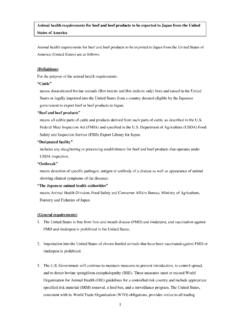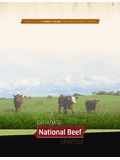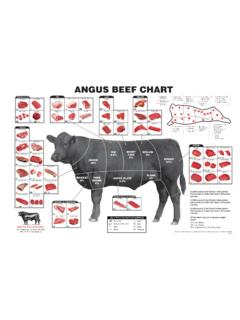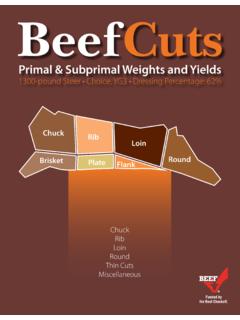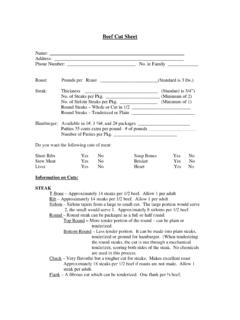Transcription of Dry-Aging of Beef - beefissuesquarterly.com
1 Dry-Aging of Beefexecutive SummAryPrepared for the National Cattlemen s beef Association sCenter for Research & Knowledge ManagementJeff W. Savell, Professor and Manny Rosenthal Chairholder,Texas A&M UniversityDry- aging of beef executive SummAryDry aging beef to enhance its flavor and tenderness is used by a very small number of meat purveyors for upscale hotels and restaurants and by an even smaller number of retailers for the gourmet market. Dry aging is a process whereby beef carcasses, primals, and/or subprimals are stored without protective packaging at refrigeration temperatures for one to five weeks to allow the natural enzymatic and biochemical processes that result in improved tenderness and the development of the unique flavor that can only be described as dry-aged beef .
2 Dry aging beef may be more art than science. Popular articles, sales brochures, and Web sites devoted to promoting or merchandising dry-aged beef use terms such as buttery and rich, superb in taste and texture, superior in taste and tenderness, mellow and intense, and earthy and nutty to describe the advantages for dry-aged compared to wet-aged beef . In fact, differentiating between dry-aged and wet-aged beef has been a relatively recent event. Up until the development of vacuum packaging and boxed beef in the 1960s, if beef were to be aged, the only option would have been to dry age it.
3 As vacuum packaging became an alternate way to ship beef , first in the and then internationally, its dominance as the primary way beef was transported, stored, and aged took off in the 1970s. By the 1980s, well over 90% of beef marketed was in this form. Compared to the historic way beef was handled, the advantages of vacuum packaging were such that avoiding shrinkage and trim loss made economic sense to both the packer/processor and retail/foodservice sectors. Two very important scientific articles published in the 1970s Minks and Stringer (1972) and Hodges et al.
4 (1974) demonstrated the advantages of vacuum packaging from a shrinkage and shelf-life standpoint without sacrificing palatability traits found in unpackaged beef . The growth of boxed beef , for the most part, transformed how steaks and roasts were prepared for the foodservice and retail channels, making the dry aging process a minor contributor to the processes used in purveying and retailing to the volume of research studies on a wide variety of topics related to beef , dry aging has not been the subject for much scientific literature.
5 Studies devoted to the direct comparison of dry aging to wet aging may be limited in number but are not limited in the quality of the work reported. This review will focus on the advantages and disadvantages of the dry aging process with special emphasis on quality, palatability, and economic parameters important to those who market and purchase this product. And not all dry aging is focused on improving the flavor and tenderness of beef . The University of Wisconsin Center for Meat Process Validation concluded that dry aging is an intervention treatment to reduce pathogens on beef carcasses (Algino et al.)
6 , 2007), giving this age-old process new life in the food safety Trod UCTI ondry- aging P ArAme Ter SPRoCEdUREsIn developing dry aging beef guidelines, the primary factors to consider are: (1) days of aging , (2) storage temperature, (3) relative humidity, and (4) air flow. These are important as they relate to development of Dry-Aging of beef executive SummAryflavor notes, shelf-life, product shrinkage, microbial spoilage, and other issues of quality and economics. Air flow has not been addressed from a research standpoint; however, there are some parameters that help ensure this process is conducted in the best manner.
7 Special wire racks, perforated shelves, trees or hooks are used to hold products for dry aging so that all surfaces are exposed to the cold temperatures to allow for uniform drying and to minimize spoilage and resulting off-odor development. It is not uncommon to find supplementary fans in dry aging coolers to help in the movement of air around products to assist in the drying process. Some commercial dry aging coolers use ultraviolet light as a way to retard microbial spoilage. not all uses of ultraviolet light require direct exposure to the dry-aged product.
8 Warren and Kastner (1992) obtained dry-aged beef from a cooler where the air was recirculated every 30 minutes through ultraviolet light before it reentered the of AgiNgThe number of days products are dry-aged varies tremendously in practice as well as in the literature. Smith (2007) found no differences in overall like, flavor like, tenderness like, and level of tenderness when aging (dry and wet aging combined) periods of 14, 21, 28, and 35 days were compared. However, when Warner-Bratzler shear force values were compared over these four aging periods, Smith (2007) found significant decreases with a 17% reduction in shear force from 14 to 35 days, showing that at least from an objective tenderness assessment standpoint, tenderness improvements were still occurring.
9 Campbell et al. (2001) compared dry aging periods of 7, 14, and 21 days with minor benefits found in some palatability traits for increased aging , but, for the most part, no real advantages for extended aging past 14 days. Determining the number of days of dry aging seems to be based more on personal preference than any scientific literature where findings support a definite minimum or maximum days of storage. Dry aging periods of 14 to 35 days have all appeared to be effective in producing the desired results of this process, but there does not seem to be a magical threshold where sufficient time is required beyond about 14 days to truly call this beef dry aged from a performance standpoint.
10 Without question, there are various opinions on length of dry aging , and purveyors of such products are passionate about their programs. Unfortunately, the scientific information is so limited that it cannot be used to support a minimum resommended period of dry TEMPERATURET emperature of storage is critical in that if it is below freezing temperatures for meat (-2 to -3 C), the enzymatic processes involved with aging will cease. If the temperature of storage is elevated, the enzymatic processes involved with aging will work quite well, but so will the microbial spoilage process resulting in the development of off-odors and off-flavors.
